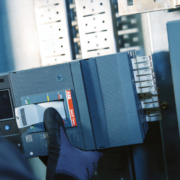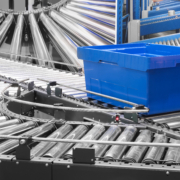New automatic transfer switch technology enables panel builders and OEMs to expand project opportunities
The size and complexity of traditional, multi-component automatic transfer switches created issues for panel builders and OEMs. But today, there are compact, all-in-one switch solutions that open the door to new applications and markets.
It’s natural for buyers to stick with products they know and trust. However, they will eventually need to branch out or risk being left behind by customers eager for the improved features and functions available in the current era of technology.
For many applications that call for an automatic transfer switch (ATS), including critical power applications, now is an important time for panel builders and OEMS to look again and consider the many features available on the latest generation of these devices. There are simpler, new and improved switches, that enable building of significantly more functional panels and systems.
All-in-one-unit creates simplicity
ATS functionality has historically been provided using a collection of individual components (controllers, sensors, switch mechanisms, etc.) that needed to connect with one another. This was a rather complex approach, with every component and every connection adding a potential point of failure, creating a major drawback to this multi-device approach.
The size and complexity of traditional, multi-component automatic transfer switches created issues for panel builders and OEMs. But today, there are compact, all-in-one switch solutions that open the door to new applications and markets.
Today, it’s possible to spec a far simpler all-in-one ATS solution with all the required components housed in a single unit with a single cable connection. This design creates many important benefits for the panel builder/OEM and for the end user.
This all-in-one technology reduces panel-construction time by as much as 80% compared with the need to install multiple components with as many as 20 connection wires. Testing time is comparably reduced, and having a single component reduces the amount of panel space required.
For end users, the benefits include increased reliability because there are far fewer connections and potential points of failure. They also benefit from faster repair times, replacing components in minutes rather than hours. Finally, this technology reduces the number of spare parts needed on hand compared to traditional ATS designs.
Automatic commissioning reduces project time
Commissioning a traditional ATS required time-consuming manual setup of a number of parameters. The latest ATS technology can automatically sense the voltage level, phase order, frequency type, and other variables. Only a few variables need to be set manually. Once the ATS has been programmed, the configuration files can be saved, downloaded, and then uploaded into other switches. This not only reduces programming time by up to 80%, but also eliminates the potential for human error in set up. These errors could result in costly damage to the ATS or connected devices/systems.
Modular construction and self-diagnostics streamline maintenance
The worst, but probably most common, time for an end user to learn that their ATS needs maintenance is when it fails to perform as expected. It’s far better to service and/or replace the ATS while it’s still performing as expected, but that can be difficult with a traditional multi-component design. Asset health is typically assessed by a visual inspection of the contacts for wear, which is a highly subjective approach.
Today, some switches track energy usage and number of cycles/operations to calculate an expected remaining life. Some also greatly improve on measuring device temperature, which is a reliable indicator of potential issues. Instead of the traditional technique of occasional temperature with an infrared gun, some switches feature an integrated temperature sensor.
A properly maintained ATS can provide 20 to 25 years of reliable service. Still, a survey of building managers revealed that 25% of units failed while they were less than five years old. It’s important for end users to have an accurate, current picture of their actual ATS health.
Today, you can specify an ATS that includes self-diagnostics that constantly monitor critical functional variables. The condition of the ATS can be checked via the HMI, plus available communication options also enable remote alarms or alerts so preventive maintenance can be performed and device failures avoided.
The key ATS-health-related variable, is the number and severity of operation cycles. By tracking the number of operations and the energy transferred during each operation, today’s more intelligent automatic transfer switches can determine when service is appropriate and can calculate the potential remaining life.
The modular construction of an all-in-one ATS makes it possible to easily and quickly swap out only the failing or damaged modules. Downtime to replace a module can be as little as 10 minutes.
Flexibility simplifies sourcing
For panels requiring an ATS in the 200-to-480-volt range, it was typically necessary to select a switch designed for the desired voltage. The intelligence built into the current generation of ATS enables it to automatically adapt to any voltage within that range. Setting the voltage is actually part of the auto-configuration function. The switch senses and adjusts to the voltage present.
For panel builders and OEMs, this reduces the need to stock multiple switches for different voltages. One ATS can do the job across the range of voltages.
Designed with safety in mind
A final end-user benefit of some of the newest switches are added safety features. As one example, supply voltage has typically been present at the door, creating the possibility for operators or technicians to come in contact with dangerous voltage levels. Newer ATS designs contain the supply voltage internally; the only connections to the door are low-voltage HMI cables.
Choose advanced ATS solutions for future opportunities
Considering all the valuable new features and functions available in current-generation all-in-one ATS units, panel builders and OEMs could increase market reach by looking at incorporating an ATS into new designs or updating the components you are specifying. The simplicity and compact size of all-in-one ATS solutions can open the door to new applications and markets. Your customers will appreciate the increased reliability and reduced maintenance requirements.
See related blog post “3 Things to think about when selecting an automatic transfer switch“.
—
Babu Chinnasamy
Product Marketing Manager
Gustavo Iaqueli
Product Marketing Manager












